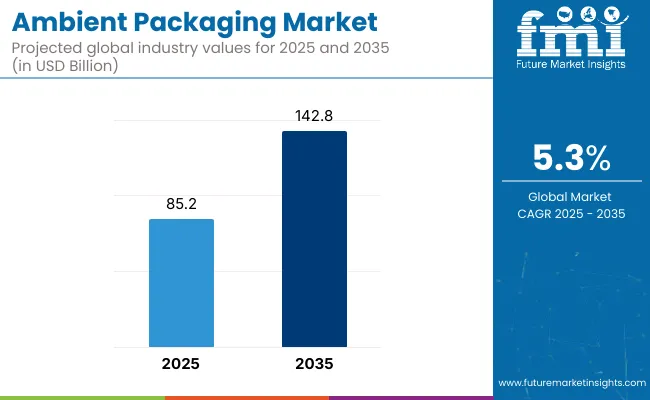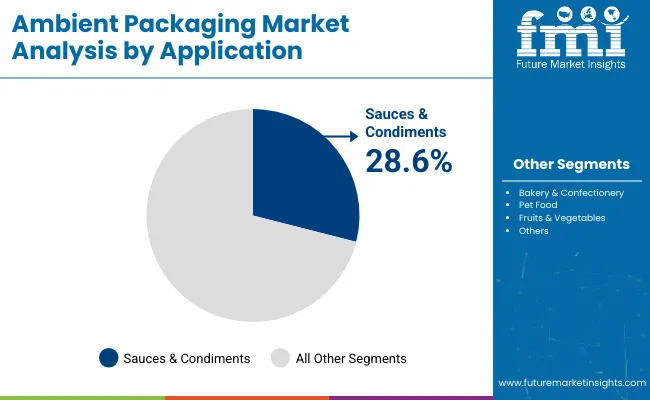The ambient packaging market is projected to grow from USD 85.2 billion in 2025 to USD 142.8 billion by 2035, registering a CAGR of 5.3%. The estimated 2024 sales value stood at approximately USD 80.9 billion. The market is being driven by demand for long-shelf-life food and beverages across retail and online channels.
Growth is underpinned by rising urbanization, global cold-chain limitations, and rising consumer preference for pantry-ready goods. Shelf-stable formats using high-barrier films, multilayer cartons, and retort packaging are becoming essential for heat-treated, aseptically processed, and ready-to-eat product lines sold without refrigeration.

| Metric | Value |
|---|---|
| Industry Size (2025E) | USD 85.2 billion |
| Industry Value (2035F) | USD 142.8 billion |
| CAGR (2025 to 2035) | 5.3% |
The ambient packaging segment is undergoing material optimization through co-extrusion, nano-coating, and sterilization-compatible films that maintain food safety at room temperature. Innovations include antimicrobial layers, oxygen scavengers, and intelligent sensors that alert on spoilage. Automation in retort tray and flexible pouch lines is improving process integrity and sealing consistency. Printable coatings with heat resistance allow for complex branding and nutritional labeling. Manufacturers are also developing peelable films and reclosable solutions to meet portion-control demands. These advancements are streamlining ambient packaging integration across e-commerce, private-label brands, and export-grade SKUs without reliance on refrigeration.
The ambient packaging market is expected to gain from regulatory emphasis on food safety and shelf stability in emerging and developed markets. Retailers are pushing for packaging formats that reduce spoilage, enable longer transport cycles, and fit shelf display standards. Brands are responding with packaging systems that combine extended shelf life with minimal preservatives. Growth in nutraceuticals, ready meals, and global pantry goods will elevate demand for flexible, aseptic, and retort-compatible designs. Strategic focus will lie in strengthening supplier-retailer partnerships, investing in barrier material R&D, and expanding market access through recyclable and mono-material ambient packaging lines.
The market has been segmented by material, product type, application, and region. Material types such as plastic, paper & paperboard, and glass have been adopted to support barrier protection, sustainability goals, and visibility in ambient shelf-stable packaging. Product type segmentation includes flexible options like bags, pouches, films, and stick packs, alongside rigid formats such as boxes, jars, and containers to cater to diverse durability, transportation, and product preservation requirements.
Applications span sauces, bakery items, pet food, and fresh produce each demanding specific ambient stability and consumer convenience standards. Regional segmentation includes North America, Europe, Asia-Pacific, Latin America, and the Middle East & Africa, reflecting evolving dietary patterns, infrastructure development, and packaging innovation in ambient food storage.

Flexible packaging products are expected to hold a 61.5% share of the ambient packaging market in 2025, driven by their barrier performance and reduced material usage. Pouches, sachets, and laminated films have enabled extended shelf life for ready-to-eat and room-temperature-stored foods. Lightweight formats have supported efficient logistics and minimized breakage risks in ambient distribution environments.
These structures have been selected for their ability to accommodate heat sealing, vacuum packaging, and inert gas flushing. Multilayer laminates have provided protection against oxygen, moisture, and light. Their adaptability to high-speed filling lines has made them ideal for ambient food packaging operations. Brand differentiation through digital printing and resealable features has further supported growth in this segment.

The sauces & condiments application segment is projected to account for 28.6% share of the market in 2025, backed by growth in retail and foodservice packaging. Portion-controlled sachets and pouches have been widely adopted for ketchup, mayonnaise, salad dressings, and hot sauces. Their compact, tamper-evident design has catered to convenience-seeking consumers and quick-service restaurants.
Ambient stability has been ensured using high-barrier materials and aseptic filling processes. These formats have allowed extended shelf life without refrigeration, supporting regional distribution across varied climates. Emerging flavors and global cuisines have led to a surge in SKUs, prompting the use of flexible packaging for both single-serve and bulk condiment formats. Branding and co-packing flexibility have also been enabled.
Ambient packaging refers to packaging for food that is sterilized and pasteurized that will increase the shelf life at room temperature. Need for a better packaging solution that helps the food and beverage to remain under certain temperature even without a refrigerator. Numerous techniques of food preservation are designed to ensure the freshness of the foods packed in the retail stores.
Ambient packaging has become a trend in the packaging and the food industry as it is highly preferred by consumers because of the ease and comfort that it offers. Increasing demand for saving empty spaces in refrigerator compartments calls for the adoption of packaging solutions that enables storage of products at room temperature assuring safety, consumer convenience and attractive designs.
There are various packaging types segmented into flexible and rigid packaging; flexible packaging being the most commonly used packaging as it provides comfort ad product safety while transportation.
Comparing with the usual packaging solutions, ambient packaging bestows a longer shelf life as it involves the use of barrier sheets in the packaging products such as cups, trays, bottles, bags, pouches and many others. Concerns about food safety, contamination scare, appealing designs of the packaging product and consumer convenience, all lead to the increasing growth of ambient packaging globally.
Manufacturers determine the extrinsic and intrinsic properties that affect the quality and safety of the product that includes the process of sterilization and pasteurization of the product to be stored. The ongoing trend of using sustainable packaging products is fueling the global ambient packaging market as it can be reused for secondary purposes.
Companies such as Del Monte Foods who believe in providing nutritious fruits and vegetables without sacrificing the freshness of the product prefers to use a sterilized packaging solution that prompts the growth of the global ambient packaging.
Usage of plastic has been banned in various countries like Kenya, Utopia, France, Austria, Italy and many others have highly affected the usage of ambient packaging as it majorly uses plastic as the material type. Plastic packaging promotes pollutions that do not support environmental concerns.
Manufacturers are striving hard to meet the consumer need and requirements that are environmentally friendly and sustainable so, most key players are investing in R&D to develop an innovative packaging solution that can be reused and recycled properly. However, the high production cost is not favourable to the manufacturers acting as a restraint factor in the growth of the ambient packaging market.
Key global players of the Ambient Packaging Market are:
Sustainability in ambient packaging is increasingly becoming a key requirement in the market. FFP packaging solutions ltd have developed a recyclable solution; a PE laminate that can be recycled using carrier bags from shopping malls and retail stores which will be supplied in the packaging format as sachets, pouches, pre-made bags or more.
Owing to the increase in consumption of frozen foods such as fruits and vegetables in North America induce the demand for ambient packaging. The lifestyle of the baby boomers and millennial in North America has considerably changes over time due to the hectic schedule which led them to prefer low-cost products and thrive on quality and freshness.
Explore Similar Insights

Thank you!
You will receive an email from our Business Development Manager. Please be sure to check your SPAM/JUNK folder too.
Chat With
MaRIA